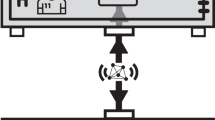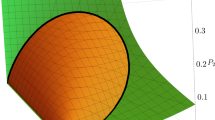Abstract
Local realism is the idea that objects have definite properties whether or not they are measured, and that measurements of these properties are not affected by events taking place sufficiently far away1. Einstein, Podolsky and Rosen2 used these reasonable assumptions to conclude that quantum mechanics is incomplete. Starting in 1965, Bell and others constructed mathematical inequalities whereby experimental tests could distinguish between quantum mechanics and local realistic theories1,3,4,5. Many experiments1,6,7,8,9,10,11,12,13,14,15 have since been done that are consistent with quantum mechanics and inconsistent with local realism. But these conclusions remain the subject of considerable interest and debate, and experiments are still being refined to overcome ‘loopholes’ that might allow a local realistic interpretation. Here we have measured correlations in the classical properties of massive entangled particles (9Be+ ions): these correlations violate a form of Bell's inequality. Our measured value of the appropriate Bell's ‘signal’ is 2.25 ± 0.03, whereas a value of 2 is the maximum allowed by local realistic theories of nature. In contrast to previous measurements with massive particles, this violation of Bell's inequality was obtained by use of a complete set of measurements. Moreover, the high detection efficiency of our apparatus eliminates the so-called ‘detection’ loophole.
This is a preview of subscription content, access via your institution
Access options
Subscribe to this journal
Receive 51 print issues and online access
$199.00 per year
only $3.90 per issue
Buy this article
- Purchase on Springer Link
- Instant access to full article PDF
Prices may be subject to local taxes which are calculated during checkout


Similar content being viewed by others
References
Clauser, J. F. & Shimony, A. Bell's theorem: experimental tests and implications. Rep. Prog. Phys. 41, 1883–1927 (1978).
Einstein, A., Podolsky, B. & Rosen, N. Can quantum-mechanical description of reality be considered complete? Phys. Rev. 47, 777–780 (1935).
Bell, J. S. On the Einstein-Podolsky-Rosen paradox. Physics 1, 195–200 (1965).
Bell, J. S. in Foundations of Quantum Mechanics (ed. d'Espagnat, B.) 171–181 (Academic, New York, 1971).
Clauser, J. F., Horne, M. A., Shimony, A. & Holt, R. A. Proposed experiment to test local hidden-variable theories. Phys. Rev. Lett. 23, 880–884 (1969).
Freedman, S. J. & Clauser, J. F. Experimental test of local hidden-variable theories. Phys. Rev. Lett. 28, 938–941 (1972).
Fry, E. S. & Thompson, R. C. Experimental test of local hidden-variable theories. Phys. Rev. Lett. 37, 465–468 (1976).
Aspect, A., Grangier, P. & Roger, G. Experimental realization of Einstein-Podolsky-Rosen-Bohm Gedankenexperiment: a new violation of Bell's inequalities. Phys. Rev. Lett. 49, 91–94 (1982).
Aspect, A., Dalibard, J. & Roger, G. Experimental test of Bell's inequalities using time-varying analyzers. Phys. Rev. Lett. 49, 1804–1807 (1982).
Ou, Z. Y. & Mandel, L. Violation of Bell's inequality and classical probability in a two-photon correlation experiment. Phys. Rev. Lett. 61, 50–53 (1988).
Shih, Y. H. & Alley, C. O. New type of Einstein-Podolsky-Rosen-Bohm experiment using pairs of light quanta produced by optical parametric down conversion. Phys. Rev. Lett. 61, 2921–2924 (1988).
Tapster, P. R., Rarity, J. G. & Owens, P. C. M. Violation of Bell's inequality over 4 km of optical fiber. Phys. Rev. Lett. 73, 1923–1926 (1994).
Kwiat, P. G., Mattle, K., Weinfurter, H. & Zeilinger, A. New high-intensity source of polarization-entangled photon pairs. Phys. Rev. Lett. 75, 4337–4341 (1995).
Tittel, W., Brendel, J., Zbinden, H. & Gisin, N. Violation of Bell inequalities by photons more than 10 km apart. Phys. Rev. Lett. 81, 3563–3566 (1998).
Weihs, G. et al. Violation of Bell's inequality under strict Einstein locality conditions. Phys. Rev. Lett. 81, 5039–5043 (1998).
Aspect, A. Bell's inequality test: more ideal than ever. Nature 398, 189–190 (1999).
Gisin, N. & Zbinden, H. Bell inequality and the locality loophole: active versus passive switches. Phys. Lett. A 264, 103–107 (1999).
Lo, T. K. & Shimony, A. Proposed molecular test of local hidden-variable theories. Phys. Rev. A 23, 3003–3012 (1981).
Kwiat, P. G., Eberhard, P. H., Steinberg, A. M. & Chiao, R. Y. Proposal for a loophole-free Bell inequality experiment. Phys. Rev. A 49, 3209–3220 (1994).
Huelga, S. F., Ferrero, M. & Santos, E. Loophole-free test of the Bell inequality. Phys. Rev. A 51, 5008–5011 (1995).
Fry, E. S., Walther, T. & Li, S. Proposal for a loophole free test of the Bell inequalities. Phys. Rev. A 52, 4381–4395 (1995).
Freyberger, M., Aravind, P. K., Horne, M. A. & Shimony, A. Proposed test of Bell's inequality without a detection loophole by using entangled Rydberg atoms. Phys. Rev. A 53, 1232–1244 (1996).
Brif, C. & Mann, A. Testing Bell's inequality with two-level atoms via population spectroscopy. Europhys. Lett. 49, 1–7 (2000).
Beige, A., Munro, W. J. & Knight, P. L. A Bell's inequality test with entangled atoms. Phys. Rev. A 62, 052102-1–052102-9 (2000).
Lamehi-Rachti, M. & Mittig, W. Quantum mechanics and hidden variables: a test of Bell's inequality by the measurement of the spin correlation in low-energy proton–proton scattering. Phys. Rev. D 14, 2543–2555 (1976).
Hagley, E. et al. Generation of Einstein-Podolsky-Rosen pairs of atoms. Phys. Rev. Lett. 79, 1–5 (1997).
Sackett, C. A. et al. Experimental entanglement of four particles. Nature 404, 256–259 (2000).
Feynman, R. P., Vernon, F. L. & Hellwarth, R. W. Geometrical representation of the Schrödinger equation for solving maser problems. J. Appl. Phys. 28, 49–52 (1957).
Richter, T. Cooperative resonance fluorescence from two atoms experiencing different driving fields. Optica Acta 30, 1769–1780 (1983).
Eichmann, U. et al. Young's interference experiment with light scattered from two atoms. Phys. Rev. Lett. 70, 2359–2362 (1993).
Acknowledgements
We thank A. Ben-Kish, J. Bollinger, J. Britton, N. Gisin, P. Knight, P. Kwiat and I. Percival for useful discussions and comments on the manuscript. This work was supported by the US National Security Agency (NSA) and the Advanced Research and Development Activity (ARDA), the US Office of Naval Research, and the US Army Research Office. This paper is a contribution of the National Institute of Standards and Technology and is not subject to US copyright.
Author information
Authors and Affiliations
Corresponding author
Rights and permissions
About this article
Cite this article
Rowe, M., Kielpinski, D., Meyer, V. et al. Experimental violation of a Bell's inequality with efficient detection. Nature 409, 791–794 (2001). https://doi.org/10.1038/35057215
Received:
Accepted:
Issue Date:
DOI: https://doi.org/10.1038/35057215
This article is cited by
-
Loophole-free Bell inequality violation with superconducting circuits
Nature (2023)
-
Quantum state tomography, entanglement detection and Bell violation prospects in weak decays of massive particles
Journal of High Energy Physics (2023)
-
Randomness-based macroscopic Franson-type nonlocal correlation
Scientific Reports (2022)
-
Quantum Bell nonlocality cannot be shared under a special kind of bilateral measurements for high-dimensional quantum states
Quantum Information Processing (2022)
-
Less entanglement exhibiting more nonlocality with noisy measurements
npj Quantum Information (2021)
Comments
By submitting a comment you agree to abide by our Terms and Community Guidelines. If you find something abusive or that does not comply with our terms or guidelines please flag it as inappropriate.



